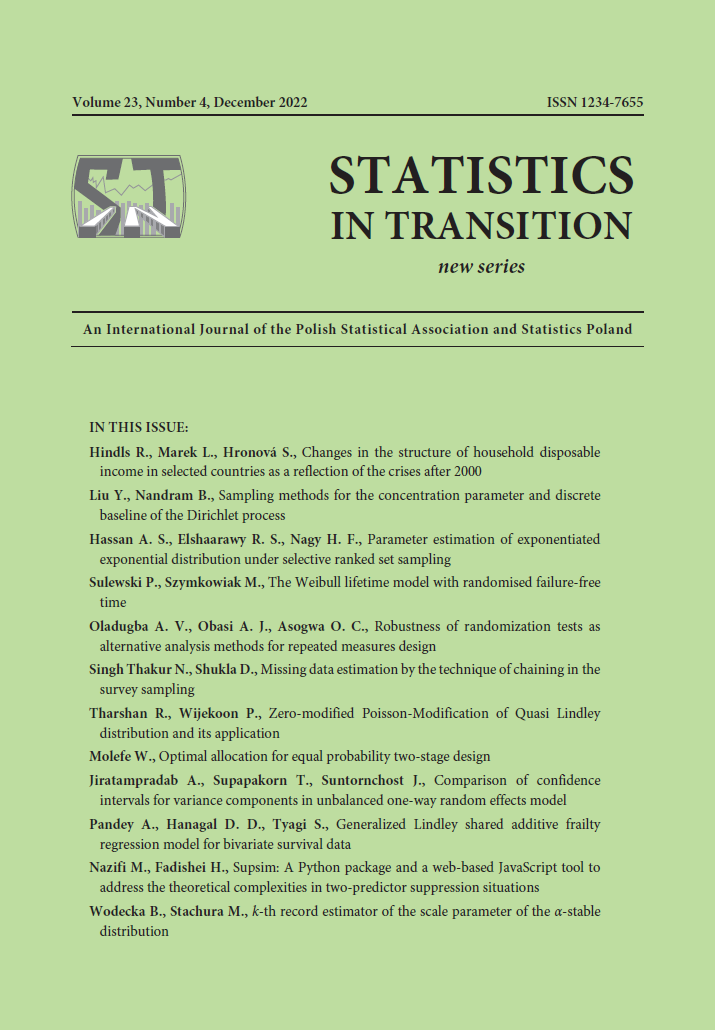ARTICLE
ABSTRACT
The paper shows that treating failure-free time in the three-parameter Weibull distribution not a constant, but as a random variable makes the resulting distribution much more flexible at the expense of only one additional parameter.
KEYWORDS
Weibull lifetime model, randomised failure-free time, compound Weibull distributions
REFERENCES
Ahrens, J. H., Dieter, U. (1982). Generating gamma variates by a modified rejection technique. Communications of the ACM, 25, pp. 47–54.
Ahrens, J. H., Dieter, U. (1974). Computer methods for sampling from gamma, beta, poisson and binomial distributions. Computing, 12, pp. 223–246.
Alamlki, S. J.,Nadarajah, S., (2014). ,Modifications of the Weibull distribution: a review. Reliability Engineering and System Safety, 124, pp. 32–55.
Balakrishnan, N., Ristic, M. M., (2016). Multivariate families of gamma-generated distributions with finite or infinite support above or below the diagonal, Journal of Multivariate Analysis, 143, pp. 194–207.
Drapella, A., (1993). Complementary Weibull distribution: Unknown or just forgotten. Quality and Reliability Engineering International, 9, pp. 383–385.
Drapella, A., (1999). An improved failure-free time estimation method. Quality and Reliability Engineering International, 15, pp. 235–238.
Dubey, S. D. (1968). A compound Weibull distribution. Naval Research Logistics Quarterly, 15, pp. 179–188.
Gertsbakh, I. B., Kordonskiy, K. H. B., (1969). Models of failure, Verlag: Springer.
Kao, J. H. K. (1966). Lifetime models with applications, In: Reliability Handbook. W.G. Ireson Editor-in-chief. McGraw-Hill Company.
Kao, J. H. K. (1960). A summary of some new techniques on failure analysis, Proc. Sixth Natl. Symp. on Reliability and Quality Control.
Kececioglu, D. (1991). Reliability Engineering Handbook, New York: Prentice Hall, Eaglewood Cliffs.
Kendall, M. G., Stuart, A. (1961). The advanced theory of statistics, Vol. 2, Charles Griffin and Company.
Lai, C. D. (2014). Generalized Weibull Distributions, New York: Springer.
Lai, C. D., Xie, M. (2006). Stochastic ageing and dependence for reliability, Springer Science and Business Media.
Lam, S. W., Halim, T., Muthusamy, K. (2010). Models with failure-free life—Applied review and extensions, IEEE Transactions on Device and Materials Reliability, 10(2), pp. 263–270.
Mahmood, S. W., Algamal, Z. Y. (2021). Reliability Estimation of Three Parameters Gamma Distribution via Particle Swarm Optimization, Thailand Statisticia, 19(2), pp. 308–316.
Mudholkar, G. S., Srivastava, D. K., (1993). Exponentiated Weibull family for analyzing bathtub failure-rate data IEEE Transactions on Reliability, 42, pp. 299–302.
Murthy, D. N. P., Xie, M., Jiang, R., (2004). Weibull models, Hoboken: Wiley. O’Connor, P. D. T. (1985). Practical reliability engineering, New York: Wiley.
Park, C. (2018). A Note on the Existence of the Location Parameter Estimate of the Three- Parameter Weibull Model Using the Weibull Plot, Mathematical Problems in Engineering, 10(2), pp. 1–6.
Qutb, N., Rajhi, E., (2016). Estimation of the Parameters of Compound Weibull Distribution, IOSR Journal of Mathematics, 12, pp. 11–18.
Ramakrishnan, M., Viswanathan, N., (2017). Comparing the methods of estimation of three-parameterWeibull distribution, IOSR Journal of Mathematics, 13(1), pp. 42–45.
Rossberg, H. J., Jesiak, B., Siegel, G., (1985). Analytic Methods of Probability Theory, Berlin: Academie Verlag.
Saffawy, S. Y., Algmal, Z. Y (2006). The Use of Maximum Likelihood and Kaplan-Meir method to Estimate the Reliability Function An Application on Babylon Tires Factory, Tanmiyat Al-Rafidain, 82(28), pp. 9–20.
Seidel, W. (2010). Mixture model, In Lovric, M., International Encyclopedia of Statistical Science, Heidelberg: Springer.
Stacy, E.W., (1962). A generalization of the gamma distribution, The Annals of Mathematical Statistics, pp. 1187–1192.
Szymkowiak, M. (2018a). Characterizations of distributions through aging intensity, IEEE Transactions on Reliability, 67(2), pp. 446–296.
Szymkowiak, M. (2018b). Generalized aging intensity functions, Reliability Engineering and System Safety, 178, pp. 198–208.
Szymkowiak, M., (2020). Lifetime analysis by aging intensity functions, Cham: Springer. Weber, M. D., Leemis, L. M., Kincaid, R. (2006). Minimum Kolmogorov–Smirnov test statistic parameter estimates, Journal of Statistical Computation and Simulation, 76(3), pp. 195–206.
Weibull, W. (1951). A statistical distribution function of wide applicability, Journal of Applied Mechanics, 18, pp. 29–296.
Wichura, M. J., (1988). Algorithm AS 241: The percentage points of the normal distribution, Applied Statistics, 37, pp. 477–484.
